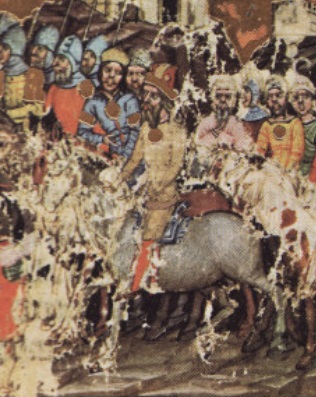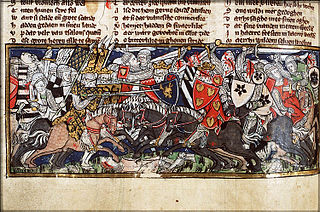Related Research Articles

The Huns were a nomadic people who lived in Central Asia, the Caucasus, and Eastern Europe between the 4th and 6th century AD. According to European tradition, they were first reported living east of the Volga River, in an area that was part of Scythia at the time; the Huns' arrival to Europe is associated with the migration westward of an Iranian people, the Alans. By 370 AD, the Huns had arrived on the Volga, and by 430, they had established a vast, if short-lived, dominion in Europe, conquering the Goths and many other Germanic peoples living outside of Roman borders and causing many others to flee into Roman territory.

Bleda was a Hunnic ruler, the brother of Attila the Hun.
The Hunnic language, or Hunnish, was the language spoken by Huns in the Hunnic Empire, a heterogeneous, multi-ethnic tribal confederation which invaded Eastern and Central Europe, and ruled most of Pannonian Eastern Europe, during the 4th and 5th centuries CE. A variety of languages were spoken within the Hun Empire. A contemporary report by Priscus has that Hunnish was spoken alongside Gothic and the languages of other tribes subjugated by the Huns.
Charaton was one of the first kings of the Huns.

Uldin, also spelled Huldin is the first ruler of the Huns whose historicity is undisputed.
By the name Edeko are considered three contemporaneous historical figures, whom many scholars identified as one:

Balamber was ostensibly a chieftain of the Huns, mentioned by Jordanes in his Getica. Jordanes simply called him "king of the Huns" and writes the story of Balamber crushing the tribes of the Ostrogoths in the 370s; somewhere between 370 and more probably 376 AD.

Laudaricus was a prominent Hunnic chieftain and general active in the first half of the 5th century.
The history of the Huns spans the time from before their first secure recorded appearance in Europe around 370 AD to after the disintegration of their empire around 469. The Huns likely entered Western Asia shortly before 370 from Central Asia: they first conquered the Goths and the Alans, pushing a number of tribes to seek refuge within the Roman Empire. In the following years, the Huns conquered most of the Germanic and Scythian tribes outside of the borders of the Roman Empire. They also launched invasions of both the Asian provinces of Rome and the Sasanian Empire in 375. Under Uldin, the first Hunnic ruler named in contemporary sources, the Huns launched a first unsuccessful large-scale raid into the Eastern Roman Empire in Europe in 408. From the 420s, the Huns were led by the brothers Octar and Ruga, who both cooperated with and threatened the Romans. Upon Ruga's death in 435, his nephews Bleda and Attila became the new rulers of the Huns, and launched a successful raid into the Eastern Roman Empire before making peace and securing an annual tribute and trading raids under the Treaty of Margus. Attila appears to have killed his brother and became sole ruler of the Huns in 445. He would go on to rule for the next eight years, launching a devastating raid on the Eastern Roman Empire in 447, followed by an invasion of Gaul in 451. Attila is traditionally held to have been defeated in Gaul at the Battle of the Catalaunian Fields, however some scholars hold the battle to have been a draw or Hunnic victory. The following year, the Huns invaded Italy and encountered no serious resistance before turning back.
Basich or Basikh was a Hun military commander who co-led an invasion of Persia in 395 AD together with Kursich.
Kursich was a Hun general and royal family member. He led a Hunnish army in the Hunnic invasion of Persia in 395 AD.
Atakam was a young Hun prince who was impaled by Attila.
Mamas was a Hun royal family member who was impaled by Attila in Thrace.
Berichus or Berik was a Hun nobleman, ambassador, and lord, said to have "ruled over many villages".
Scottas or Skottas was a Hun nobleman, ambassador and advisor. He was the brother of Onegesius.
Chelchal was a Hun commander serving as lieutenant general under the Byzantine Empire.
Emnetzur was a Hun nobleman and a blood relative of Attila.
Hormidac was a military leader of the Huns who commanded an expedition against the Eastern Roman Empire in the winter of 466/467. He raided Dacia mediterranea before being defeated by Anthemius.

Hunnic art covers all forms of art produced by the Huns, an extinct Central/Eastern Asian people, during their stay in Europe between c. 370 and c. 470 AD.
References
- ↑ Maenchen-Helfen, Otto J. (2022). Knight, Max (ed.). The World of the Huns Studies in Their History and Culture. University of California Press. p. 402. ISBN 9780520357204 . Retrieved 27 October 2022.
- ↑ Kim, Hyun Jin (2015). The Huns. Taylor & Francis. ISBN 9781317340911 . Retrieved 27 October 2022.
- ↑ Kim, Hyun Jin (2013). The Huns, Rome and the Birth of Europe. Cambridge University Press. p. 93. ISBN 9781107009066 . Retrieved 27 October 2022.
- ↑ Macartney, C.A.; Péter, László (2019). Studies on Early Hungarian and Pontic History. Taylor & Francis. ISBN 9780429515170 . Retrieved 27 October 2022.
- ↑ Maenchen-Helfen, Otto J. "The World of the Huns. Chapter IX. Language". www.kroraina.com. Retrieved 27 October 2022.